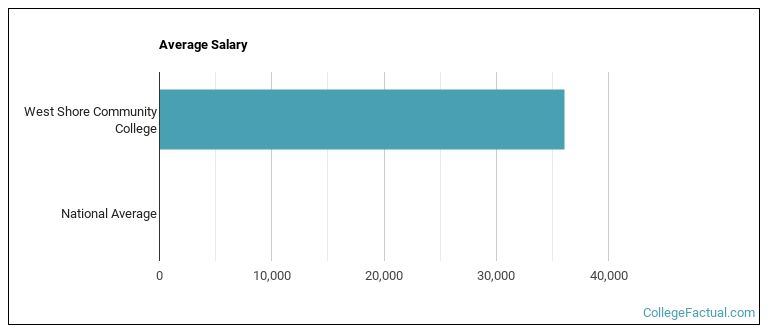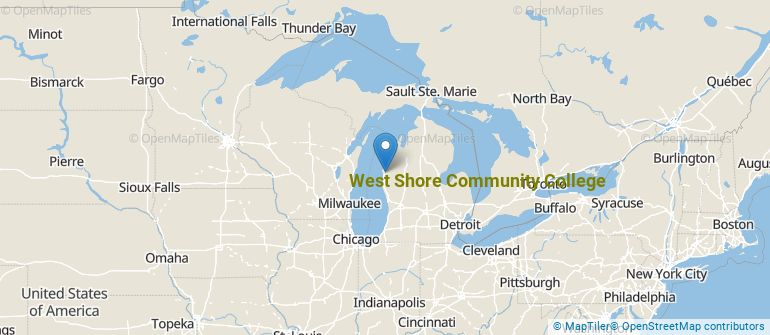 by our College Data Analytics Team
by our College Data Analytics TeamExplore the best ranked schools for the programs you are most interested in.
College Factual ranked West Shore Community College as #1,977 out of 2,152 colleges and universities in the country on its 2025 Best Colleges list.
Since West Shore Community College has an open admissions policy, being accepted to the school isn't that hard. However, a full basic things - such as a high school diploma or equivalent - may be required. Also, go over your application to make sure it is complete before you submit it.
The student to faculty ratio at West Shore Community College is an impressive 11 to 1. That's quite good when you compare it to the national average of 15 to 1. This is a good sign that students at the school will have more opportunities for one-on-one interactions with their professors.
In addition to the student to faculty ratio, some people look at what percentage of faculty members are full-time as a sign of how much time professors will be able to spend with their students. This is because part-time teachers may not be be on campus as much as their full-time counterparts.
The full-time faculty percentage at West Shore Community College is 30%. This is lower than the national average of 47%.
The freshmen retention rate is a sign of how many full-time students like a college or university well enough to come back for their sophomore year. At West Shore Community College this rate is 57%, which is a bit lower than the national average of 68%.
During the 2017-2018 academic year, there were 1,058 undergraduates at West Shore Community College with 289 being full-time and 769 being part-time.
The net price is calculated by adding tuition, room, board and other costs and subtracting financial aid.Note that the net price is typically less than the published for a school. For more information on the sticker price of West Shore Community College, see our tuition and fees and room and board pages.
Almost 66% of college students who graduated with the class of 2018 took out student loans, but that percentage varies from school to school. At West Shore Community College, approximately 2% of students took out student loans averaging $5,000 a year. That adds up to $20,000 over four years for those students.
Get more details about paying for West Shore Community College.

See which majors at West Shore Community College make the most money.
Get more details about the location of West Shore Community College.

Contact details for West Shore Community College are given below.
| Contact Details | |
|---|---|
| Address: | 3000 N Stiles Rd, Scottville, MI 49454-0277 |
| Phone: | 231-845-6211 |
| Website: | https://www.westshore.edu/ |
| Most Popular Majors | Bachelor’s Degrees | Average Salary of Graduates |
|---|---|---|
| Liberal Arts General Studies | 80 | NA |
| Nursing | 19 | NA |
| Practical Nursing & Nursing Assistants | 19 | NA |
| Precision Metal Working | 13 | NA |
| General Sales & Marketing | 12 | NA |
| Human Development & Family Studies | 12 | NA |
| Accounting | 7 | NA |
| Health & Medical Administrative Services | 6 | NA |
| Allied Health & Medical Assisting Services | 5 | NA |
| Criminal Justice & Corrections | 4 | NA |
Online learning options are becoming more and more popular at American colleges and universities. Online classes are great for students who have busy schedules or for those who just want to study on their own time.
In 2022-2023, 636 students took at least one online class at West Shore Community College. This is a decrease from the 650 students who took online classes the previous year.
| Year | Took at Least One Online Class | Took All Classes Online |
|---|---|---|
| 2022-2023 | 636 | 251 |
| 2021-2022 | 650 | 280 |
| 2020-2021 | 835 | 438 |
| 2018-2019 | 420 | 139 |
Learn more about online learning at West Shore Community College.
Footnotes
*The racial-ethnic minorities count is calculated by taking the total number of students and subtracting white students, international students, and students whose race/ethnicity was unknown. This number is then divided by the total number of students at the school to obtain the racial-ethnic minorities percentage.
References
More about our data sources and methodologies.